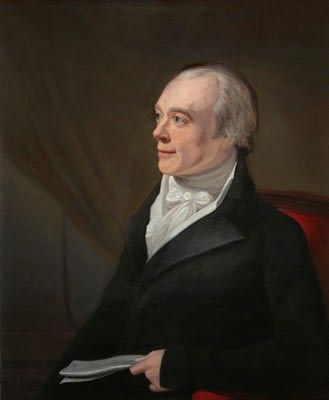
George Francis Joseph
Portrait of the Right Hon. Spencer Perceval (1762-1812), early 19th century
Oil on canvas
30 x 25 in (76 x 63.5 cm)
Philip Mould & Co.
To view all current artworks for sale visit philipmould.com The present portrait-type can be considered as the most iconic image of the Right Hon. Spencer Perceval, who was tragically...
To view all current artworks for sale visit philipmould.com
The present portrait-type can be considered as the most iconic image of the Right Hon. Spencer Perceval, who was tragically assassinated in the lobby of the House of Commons whilst in office as Prime Minister.
Unusually for a man of his time, let alone a person as prominent as a Prime Minister of Great Britain, there are no known life portraits of Spencer Perceval (Prime Minister of United Kingdom, October 1809 until his assassination, May 1812). After his assassination in 1812, however, the sculptor Nollekens fashioned a death mask, and this served as the model for a number of posthumous portraits by Joseph. These images do not refer to the statesman's murder, but instead suggest an engaging and perceptive personality, quite as one suspects that Perceval's manner and intellect may well have been depicted had he enjoyed the good fortune to sit to his portrait.
Perceval was educated at Harrow and Trinity College, Cambridge. He was elected Member of Parliament for Northampton in 1796, appointed solicitor-general under Addington in 1801 and the next year, attorney-general. He was Chancellor of the Exchequer under the Duke of Portland in 1807 and was successful with his budget scheme to convert 3 per-cent stock into terminable annuities. He succeeded Portland as Prime Minister in 1809 but found great difficulty in forming a ministry owing to the dissatisfaction of Canning and Castlereagh, and his government was generally regarded as weak. On 11 May 1812 Perceval was assassinated in the lobby of the House of Commons by John Bellingham, a bankrupt, who had a grievance against government.
George Francis Joseph was born in Dublin in 1764 although he recognized that to succeed as a painter he would have to be trained in London. At the age of twenty he entered the Royal Academy Schools and four years later began to exhibit at the Royal Academy, which he would continue to do until his death at Cambridge in 1846. In 1813 he was made an Associate of the Royal Academy in recognition of his talents. This portrait of the Right Hon Spencer Perceval, remains one of his most admired works. Versions include those in the National Portrait Gallery, the House of Commons, at Trinity College Cambridge and Apsley House.
The present portrait-type can be considered as the most iconic image of the Right Hon. Spencer Perceval, who was tragically assassinated in the lobby of the House of Commons whilst in office as Prime Minister.
Unusually for a man of his time, let alone a person as prominent as a Prime Minister of Great Britain, there are no known life portraits of Spencer Perceval (Prime Minister of United Kingdom, October 1809 until his assassination, May 1812). After his assassination in 1812, however, the sculptor Nollekens fashioned a death mask, and this served as the model for a number of posthumous portraits by Joseph. These images do not refer to the statesman's murder, but instead suggest an engaging and perceptive personality, quite as one suspects that Perceval's manner and intellect may well have been depicted had he enjoyed the good fortune to sit to his portrait.
Perceval was educated at Harrow and Trinity College, Cambridge. He was elected Member of Parliament for Northampton in 1796, appointed solicitor-general under Addington in 1801 and the next year, attorney-general. He was Chancellor of the Exchequer under the Duke of Portland in 1807 and was successful with his budget scheme to convert 3 per-cent stock into terminable annuities. He succeeded Portland as Prime Minister in 1809 but found great difficulty in forming a ministry owing to the dissatisfaction of Canning and Castlereagh, and his government was generally regarded as weak. On 11 May 1812 Perceval was assassinated in the lobby of the House of Commons by John Bellingham, a bankrupt, who had a grievance against government.
George Francis Joseph was born in Dublin in 1764 although he recognized that to succeed as a painter he would have to be trained in London. At the age of twenty he entered the Royal Academy Schools and four years later began to exhibit at the Royal Academy, which he would continue to do until his death at Cambridge in 1846. In 1813 he was made an Associate of the Royal Academy in recognition of his talents. This portrait of the Right Hon Spencer Perceval, remains one of his most admired works. Versions include those in the National Portrait Gallery, the House of Commons, at Trinity College Cambridge and Apsley House.
Be the first to hear about our available artworks
* denotes required fields
We will process the personal data you have supplied in accordance with our privacy policy (available on request). You can unsubscribe or change your preferences at any time by clicking the link in our emails.